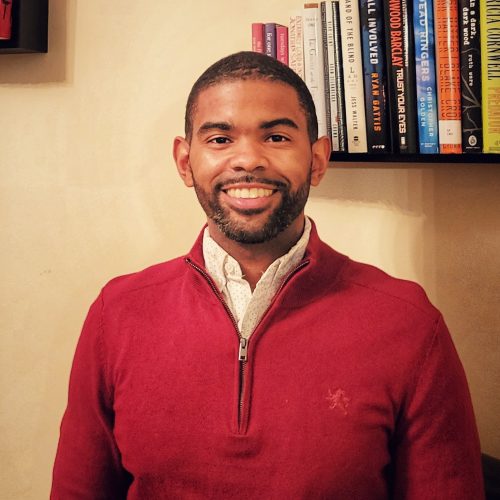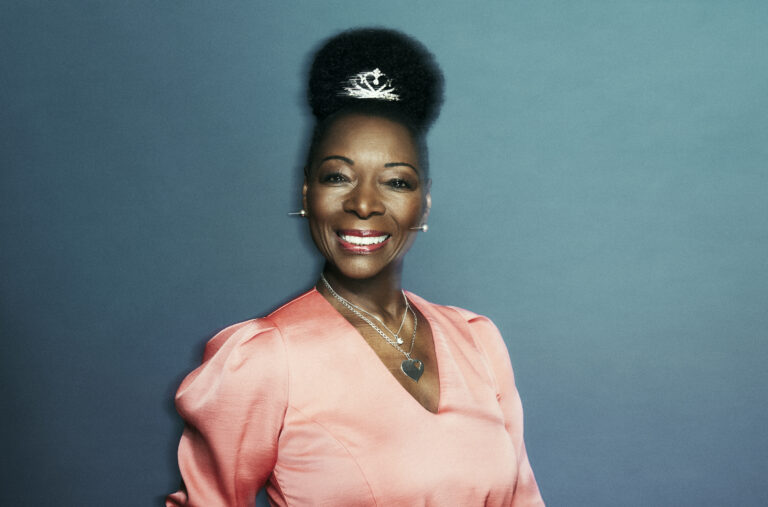The authors of Cambridge University Press’ We’re Not OK: Black Faculty Experiences and Higher Education Strategies discuss mental health, retention, and fostering an inclusive environment for Black academics.

Justin Stewart, former journalist and member of BOLD (Black Organizers, Leaders, and Doers)

Dr Antija Allen, Assistant Professor of Psychology, Pellissippi State Community College
Dr Antija Allen is an Assistant Professor of Psychology at Pellissippi State Community College with two decades of experience as an educator, and Justin Stewart is a former journalist and member of BOLD (Black Organizers, Leaders, and Doers).
Your aim is to bring awareness to obstacles faced by Black academics in postsecondary institutions. What obstacles have you faced?
JUSTIN: “One of the points that we establish in We’re Not OK, is that the obstacles of diversity, inclusion and equity extend outside of the doors of higher education. As a Black professional, I have felt the need to code-switch when the majority of my working population is white. Through code-switching, I am constantly being critical of how I dress, speak and carry myself with colleagues.
“While this strategy has been useful, and I have been able to benefit from it in my career, it has come at the cost of feeling inauthentic in certain situations. As close as I am with some of my peers, I still do not feel comfortable enough with showing different aspects of my identity as an African American male, out of fear of being stereotyped or mischaracterised due to racial biases. Due to a lack of representation, it can be hard to ‘let your hair down’ and communicate about things that are distinctively part of my Black experience. As the minority in these circles, it sometimes feels as though I continuously have to be ‘on’ in the sense of being performative.
ANTIJA: “I’ve been in higher education for almost 20 years and over that time I have held positions at multiple institutions. I have faced several obstacles over the years including microaggressions, feeling silenced, being excluded, and having to prove my competence.”
What is the dialogue you hope to invite to bring about change?
JUSTIN: “Our mission throughout We’re Not OK is to create a space where Black faculty can feel comfortable enough to share their own experiences with their peers and superiors relating to any traumas or concerns about being marginalised within their respective institutions. Being able to feel freer in expressing aspects of the Black experience, a lack of diversity and a lack of belonging will lend itself in helping others outside of the community learn and connect more, which can begin to shut down certain implicit biases. With these conversations, and with some guidance from the strategies offered in the book, institutions can begin developing new methods to break down obstacles impacting racial equality when it relates to representation, hiring practices, and inclusivity. The hope is to actually build a community with all of these differences, whether it be race, gender, sexual orientation, etc., with the power to tackle issues and develop solutions together for these minority groups.”
ANTIJA: “I remember watching a show many years ago where W. Kamau Bell and Tim Wise were being interviewed. The interviewer said something like people don’t talk about race or racism and Kamau corrected him by saying Black people do talk about race, we just may not be talking about it with white people. He made a good point. Race, racism, and discrimination in general that is faced in the workplace is discussed, but usually in private discussion with close friends. And there are of course valid reasons for why that is. This dialogue needs to be opened to include other groups so that they awareness can be raised not only of what Black faculty are facing, but also how it’s impacting us in a negative way. The hope is that this will become a much larger dialogue that will lead to decision-makers developing strategic plans that include a clear commitment to not only diversity recruitment, but also fostering an inclusive environment for Black faculty, retaining them, and promoting mental wellness. The obstacles that are faced are the reason why it is so difficult to recruit and retain Black faculty. Unless this discussion is had, the struggle to recruit and retain will remain and Black faculty will continue to face workplace trauma.”
What are the positive and negative factors that have impacted the inclusion and retention of Black academics?
JUSTIN: “With society, and the world overall, continuing to change and develop, this has challenged institutions to re-assess the dynamics of representation throughout their ranks. The traditional hierarchy of the corporate world is no longer acceptable as people have freely spoken their displeasures to this obsolete approach to business. Through tragic events such as Breonna Taylor and George Floyd, institutions have attempted to make triumphs out of tragedies by communicating their support for Black professionals and making statements to help disassemble mechanisms that have limited the ability of Black people to prosper. This call, however, hasn’t been as fruitful to this point, and infrastructures haven’t changed enough to match the energy that has been expressed and spoken, which has caused Black faculty to question their institutions sincerity. You are being asked to share your voice, and that they are listening to your concerns, but it feels like things are remaining the same in-house, regardless of what is reported to outside audiences.”
ANTIJA: “I’ll start with the negative. Since there are usually only one or only a few Black faculty at an institution, there are often feelings of isolation. There are too many instances of microaggressions followed by micro-invalidations. There commonly aren’t safe spaces or colleagues on campus for a Black faculty member to seek support from if they want to express their frustrations. For those on the tenure track, which can be an added factor because there is that feeling of not having a stable position and possibly not having one if you air your grievances. This leads to them at times leaving the institution as a result because that feeling of belonging isn’t there. The positive factors that have impacted inclusion and retention are senior leadership being vocal about their dedication to diversity, equity, and inclusion as well as developing a strategic plan that shows clear steps that will be taken to achieve DEI goals. Ensuring that Black faculty are prepared for the tenure/promotion process. Making sure that there is a college culture of inclusion and mental wellness for employees and students. Those are just a few of the negative and positive factors, there are several more detailed in the book.”
What practical strategies can you suggest to our readers, mostly DEI and HR leaders in Europe and the US?
JUSTIN: “The path to improving the state of diversity, equity, inclusion and mental health begins with creating an environment where everyone feels safe.
“In certain settings where someone is the minority of the population, there is a tug of war with identity, trying to fit in while also feeling as though he/she cannot be their authentic self. Through instilling a sense of belonging, feeling at home rather than a guest, individuals will feel more freedom to express themselves and share their own opinions on creating a more inclusive community.
“Institutionally, offering resources that promote cross-cultural engagement is an entry point to introduce and interact with diverse individuals and backgrounds through a series of channels including employee resource groups, mentoring opportunities, sponsorship opportunities, collaborations between institutions, etc. Many times, as people, we operate in a state of unknowing and are afraid to admit to our own cultural ignorance. Having these lines of communication easily accessible and frequent will lead to more insightful, provocative and stirring dialogue, which can lend a hand in diffusing implicit bias that exist when people relegate themselves to specific seats and circles at the lunch table.
“Additionally providing resources for faculty to take a mental break and address concerns will alleviate some of the added pressure that’s carried on a day to day, whether it be from a student, a peer, or a superior. This moment to not be recognized simply as an educator, but as a human being first and foremost, can provide an opportunity for relief and recharge, and to receive support as opposed to being the support.”
ANTIJA: “We are living in a time where more and more people are not staying where they do not feel valued. Justin has provided a ton of strategies, but I would add make a clear plan for racial inclusion, execute that plan, and ensure there are consequences for those that do not follow it. Don’t task the handful of diverse employees you may have with changing the culture of your organization. Invest the time and money in making changes and strengthening your institution by hiring a strong team of DEI experts to guide your strategic planning and execution. Then assess, assess, assess, and revise, revise, revise. There are some changes that will be quick, and others will take a bit more time, but in the end your employees will see and feel the difference and that will attract even more diverse employees.”
Are there any universities leading the way when it comes to racial inclusion?
JUSTIN: “In our Programs with Promise chapter, we highlight many institutions that are leading with action as it relates to racial inclusion. At North Hennepin Community College, a public community college in Brooklyn Park, MN, Dr. Rassheedah Watts, Associate Vice President of Equity & Inclusion / Chief Diversity Officer, has created a space for Black faculty through Academic Black Table Talk, established following the murder of George Floyd in 2020. With the intention to highlight the Black experience in the academy, this has been an outlet to amplify the voices of Black faculty, administrators and staff within the Minnesota State System, which consists of more than 30 universities and colleges. Discussing issues related to education, racial justice, equity and other topics related to Black identity in America, this program is accessible and inclusive to all employees and students.”
ANTIJA: “The only thing I would add is our list in the programs with promise chapter is not exhaustive by any means. There are several institutions that have been making strides in DEI and racial inclusion.”
Are you positive about the future?
JUSTIN: “I am definitely hopeful for the future and hope that this opportunity to detail these experiences and share these strategies can be another step forward to progress. This platform has allowed a transparency that I am positively sure will resonate with people. I do understand, however, that without action, words can only go so far. I believe many have led with words, but without action to create a substantial and sustainable change. As a call to action for institutions, the better question is what are they willing to do now that they’ve heard, been shown and read these cries for help?”
ANTIJA: “We are one book in a sea of several other resources, initiatives, programs, social justice workers, and changemakers. I am positive that our book is another valuable tool for the DEI, anti-racism toolbox. The response for this book has been so great and we have already been approached by organisations wishing to distribute this book to senior leadership. That tells me that there are organizations ready and willing to invest the time and money into strengthening their institutions. I believe change is coming and I am excited to see what the world looks like post-We’re Not OK.”
We’re Not OK is available on Amazon and Barnes & Noble both in hard copy and digital formats, as well as other booksellers including Blackwell’s.





